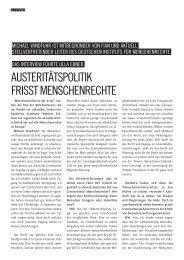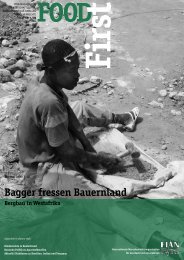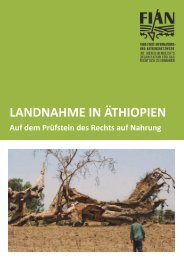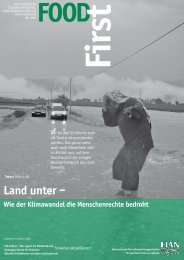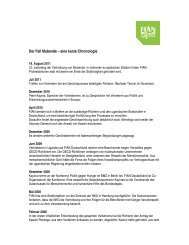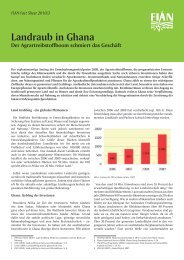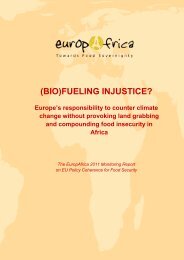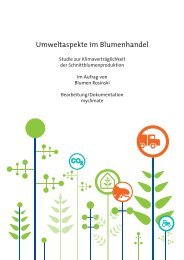Study 3: Ecodestruction and the Right to Food: The Cases of Water ...
Study 3: Ecodestruction and the Right to Food: The Cases of Water ...
Study 3: Ecodestruction and the Right to Food: The Cases of Water ...
You also want an ePaper? Increase the reach of your titles
YUMPU automatically turns print PDFs into web optimized ePapers that Google loves.
Starving <strong>the</strong> Future <strong>Study</strong> 3<br />
IV . <strong>Water</strong> as a major limiting fac<strong>to</strong>r <strong>of</strong> food production<br />
<strong>Water</strong> consumption in urban centers can be roughly described at 70 percent industrial, 20 percent<br />
institutional <strong>and</strong> 10 percent domestic. In all regions except Europe, however, <strong>the</strong> largest consumer <strong>of</strong><br />
water is agriculture. It consumes some 65 <strong>to</strong> 70 percent globally 19. In Africa <strong>and</strong> South Asia, two areas<br />
with very high rates <strong>of</strong> hunger <strong>and</strong> malnutrition, even 84 percent <strong>of</strong> water are consumed by agriculture. It<br />
should also be noted that industrial agriculture is <strong>the</strong> biggest polluter <strong>of</strong> water due <strong>to</strong> pesticides,<br />
phosphates <strong>and</strong> nitrates. Urban <strong>and</strong> in particular industrial water are increasing, which may divert water<br />
from agriculture. Agricultural yields in many areas, however, are highly dependent on irrigation: <strong>The</strong><br />
FAO observes that availability <strong>of</strong> fresh water is likely <strong>to</strong> be <strong>the</strong> major fac<strong>to</strong>r limiting food production.<br />
While it is true that hunger <strong>and</strong> malnutrition <strong>to</strong>day have more <strong>to</strong> do with lacking purchasing power or<br />
lacking access <strong>to</strong> l<strong>and</strong> <strong>and</strong> o<strong>the</strong>r resources than with <strong>the</strong> overall national availability <strong>of</strong> food, a return <strong>of</strong><br />
scarcity due <strong>to</strong> lack <strong>of</strong> irrigation water would dramatically increase <strong>the</strong> number <strong>of</strong> <strong>the</strong> hungry <strong>and</strong><br />
malnourished. Besides <strong>the</strong> overuse <strong>and</strong> destruction <strong>of</strong> <strong>the</strong> water cycle (<strong>and</strong> loss <strong>of</strong> <strong>to</strong>psoil) <strong>the</strong>re will be<br />
ano<strong>the</strong>r fac<strong>to</strong>r which would lead <strong>to</strong> additional malnutrition: Climate change will lead <strong>to</strong> changes in <strong>the</strong><br />
agricultural production patters – with some countries (basically in <strong>the</strong> global North) gaining <strong>and</strong> o<strong>the</strong>rs<br />
losing. <strong>The</strong> production losses will mainly occur in some 40 countries <strong>of</strong> <strong>the</strong> global south (with al<strong>to</strong>ge<strong>the</strong>r<br />
2 billion inhabitants – 450 million <strong>of</strong> <strong>the</strong>m currently malnourished) <strong>and</strong> could drastically swell <strong>the</strong> ranks<br />
<strong>of</strong> <strong>the</strong> malnourished. 20 Climate change would also effect <strong>the</strong> water cycle. By <strong>the</strong> year 2050 half <strong>the</strong><br />
world’s population <strong>of</strong> some 9.3 billion could be living in conditions <strong>of</strong> malnutrition <strong>and</strong> poverty.<br />
<strong>The</strong>re is still considerable scope for food production – even outside <strong>the</strong> perview <strong>of</strong> <strong>the</strong> green revolution -<br />
on <strong>the</strong> fields <strong>of</strong> marginalized peasants in <strong>the</strong> South, which currently feed more than 2 billion people.<br />
<strong>The</strong>ir production could probably be at least doubled. 21 <strong>The</strong> rising yields <strong>of</strong> green revolution technologies<br />
on <strong>the</strong> most fertile soils (feeding 2.5 billion people) seem <strong>to</strong> have reached <strong>the</strong>ir ecological limits (in terms<br />
<strong>of</strong> l<strong>and</strong> degradation, salinity <strong>and</strong> water use).<br />
In 1994-96 <strong>the</strong> South had some 702 million hectars under rainfed cultivation <strong>of</strong> major food <strong>and</strong> fiber<br />
crops. <strong>The</strong> irrigated area amounted <strong>to</strong> an additional 208 million hectars.<br />
L<strong>and</strong> with cultivation potential (suitable <strong>and</strong> very suitable) amounts <strong>to</strong> 1.872 million hectars, 433 million,<br />
however, in forest ecosystems. Irrigation does not make much <strong>of</strong> a difference in bringing hi<strong>the</strong>r<strong>to</strong><br />
uncultivable l<strong>and</strong> in<strong>to</strong> production. <strong>The</strong> importance <strong>of</strong> irrigation, however, is in providing a stable water<br />
supply in areas <strong>of</strong> rainfall variability. In <strong>the</strong> tropics resp. subtropics, irrigation can increase maximum<br />
yields <strong>of</strong> wheat by 20 resp. 30 percent, <strong>of</strong> rice by 24 resp. 35 percent <strong>and</strong> <strong>of</strong> maize by 23 resp 37<br />
percent.<br />
Irrigation is a very important pillar <strong>of</strong> food production in <strong>the</strong> global South: More than half <strong>of</strong> <strong>the</strong> cereals<br />
produced in <strong>the</strong> South (56%) are due <strong>to</strong> irrigation. For cereals <strong>and</strong> non-cereal crops <strong>to</strong>ge<strong>the</strong>r <strong>the</strong><br />
percentage due <strong>to</strong> irrigation in <strong>the</strong> South is still as high as 40%. 54% <strong>of</strong> irrigated l<strong>and</strong> in <strong>the</strong> South is<br />
located in India <strong>and</strong> China – countries inhabited by more than one third <strong>of</strong> humankind.<br />
<strong>The</strong> impact <strong>of</strong> irrigation on <strong>the</strong> remaining cultivable l<strong>and</strong> is still considerable. For staple food <strong>and</strong> oil<br />
crops <strong>the</strong> increase would be in <strong>the</strong> range <strong>of</strong> 13 <strong>to</strong> 30 percent. For sugar crops <strong>and</strong> cot<strong>to</strong>n even more.<br />
Future food production in <strong>the</strong> South (on all currently cultivated <strong>and</strong> all potentially cultivated l<strong>and</strong>) is<br />
sensitive <strong>to</strong> irrigation. <strong>The</strong> importance <strong>of</strong> irrigation can be unders<strong>to</strong>od by comparing yields under rain-fed<br />
<strong>and</strong> irrigated multiple cropping <strong>to</strong> yields under rain fed multiple cropping on all currently cultivated <strong>and</strong><br />
potentially cultivated l<strong>and</strong>: <strong>The</strong> difference in increase would amount <strong>to</strong> 40%.<br />
FIAN International 118<br />
June 2002



